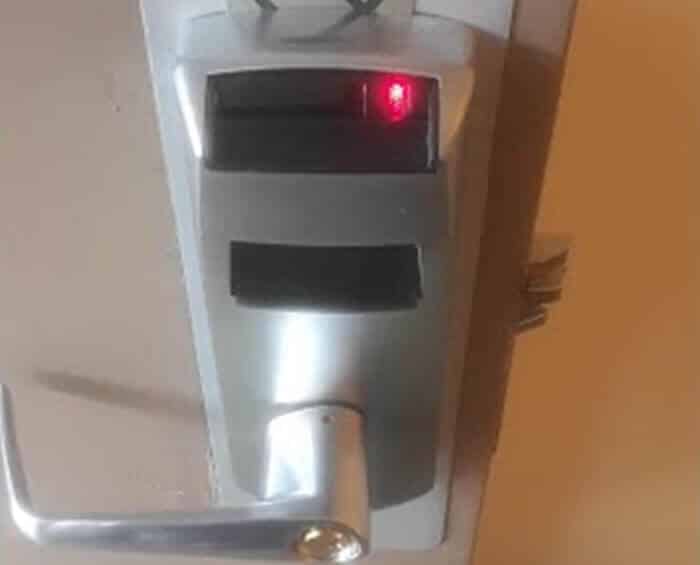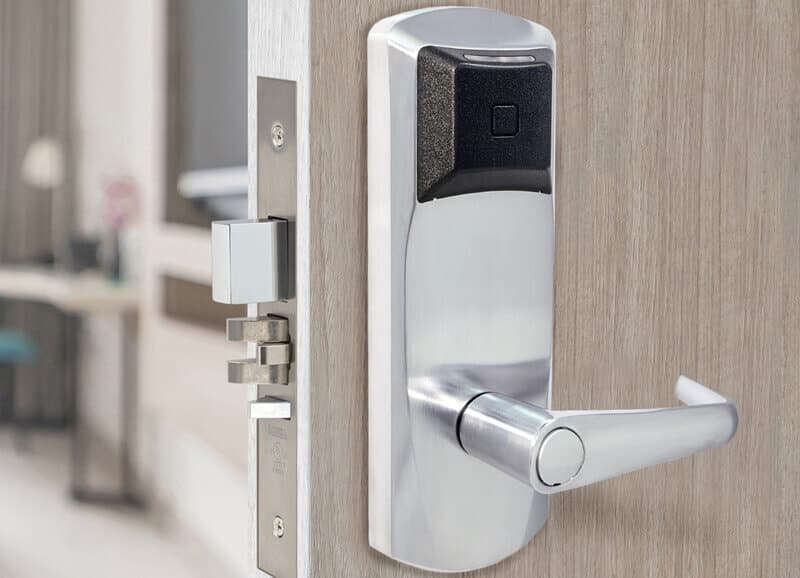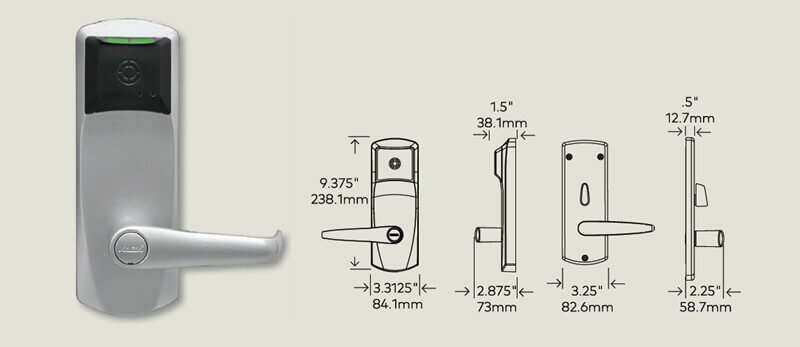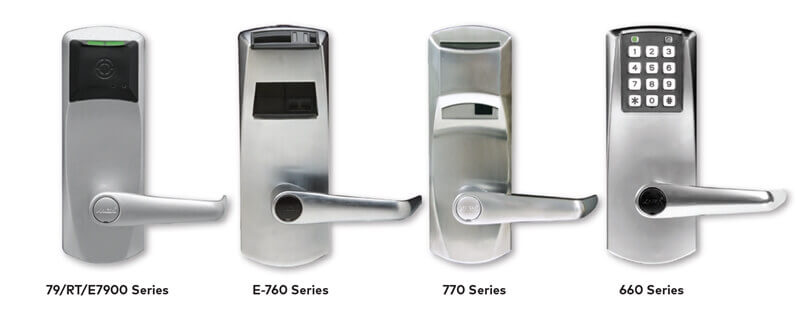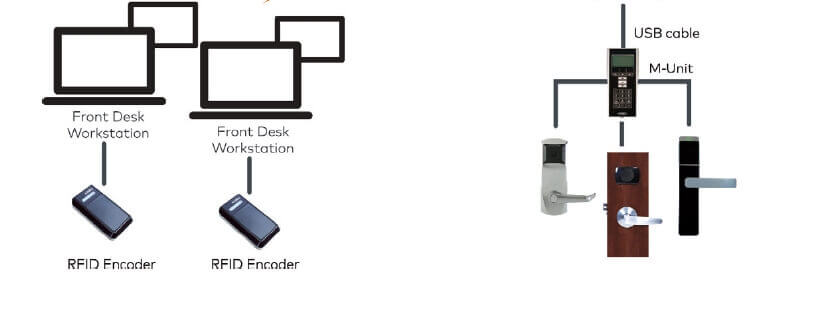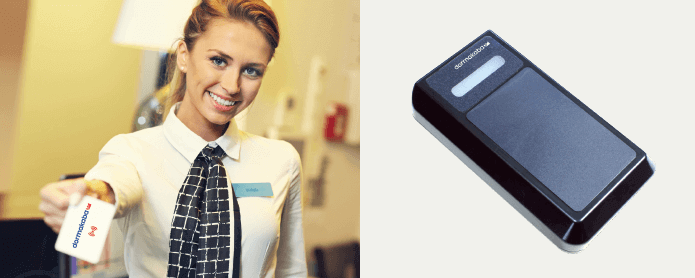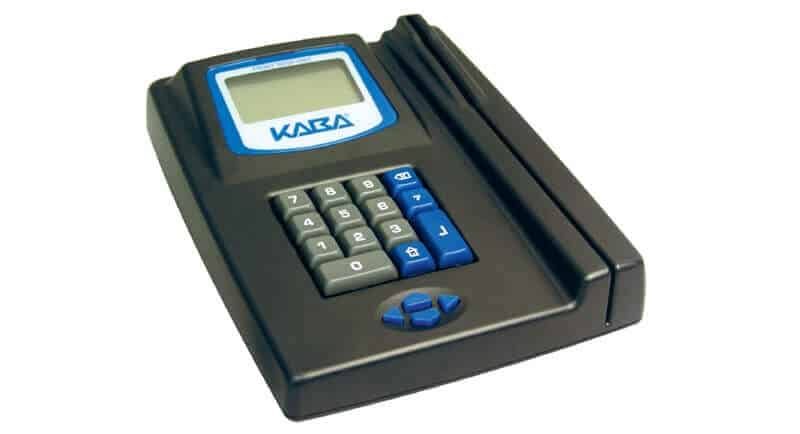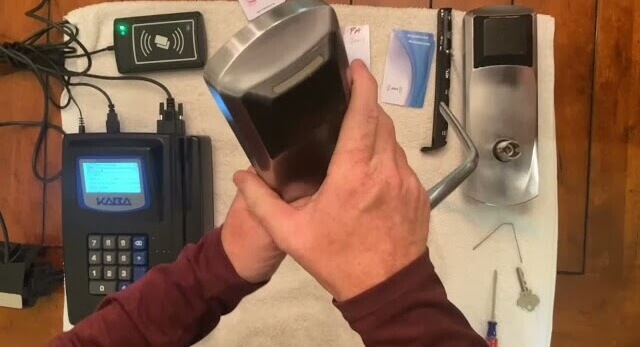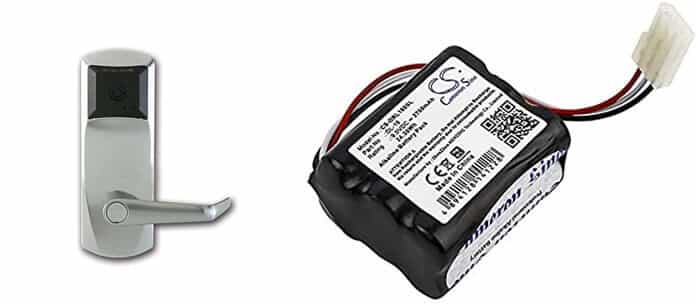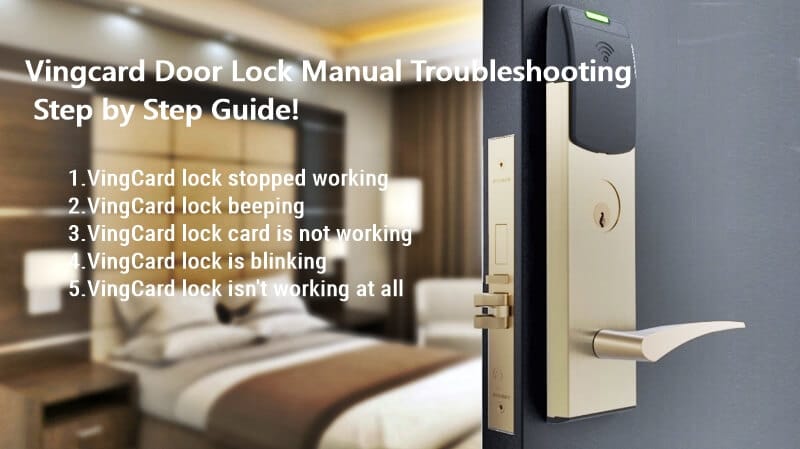Kaba Door Lock Troubleshooting: Expert Step by Step Guide
If you are using Kaba door locks for your hotels, I am sure you have faced some problems with Kaba door locks, especially when most of the once-popular KABA hotel lock models were discontinued.
Don’t worry! As a professional hotel door lock system supplier in China. ShineACS locks have covered you with this step-by-step guide to troubleshooting the most common Kaba door lock issues.
Also, we’d like to help you process Kaba door lock troubleshooting and help you replace or upgrade old Kaba hotel door locks.
Kaba lock light codes.
Kaba door locks come with a colored light that indicates their status. The following are the most common Kaba door lock light codes you’ll see:
- Greenlight: The door is locked and secure.
- Red light: The door is unlocked and not safe.
- Kaba’s door lock is blinking red, and the door won’t open, which means the battery is dead. You must replace it with a new one to get your lock working again. If you see a steady red light, there’s something wrong with your lock, and you should contact Kaba Customer Service at (888) 730-2824 for assistance.
- Yellow light: The lock is malfunctioning and needs to be serviced by a technician, most likely because a battery may need to be replaced or the wiring for the electric strike has gone wrong and will require repair from an experienced professional.
- Flashing red/flashing yellow lights (two separate lights): This means that both locks are engaged simultaneously, which could mean that there’s an issue with your hotel door lock system where it doesn’t recognize when one of these two types of locks should be in use at any given time—or even more likely, this could indicate some problem with your system itself!
- Flashing yellow indicates a problem with your access code or card, which needs to be reset by an authorized technician from Kaba. If you cannot access your building due to this issue, please contact them as soon as possible so they can help resolve it!
- Red LED lights continuously with a continuous buzzing noise; please try to reset the Kaba locks by removing the battery holder for ten seconds, then reinserting it.
- The red LED flashes for 4 seconds. Turn the outside lever downward while the red LED is flashing. The deadbolt and latch bolt retract simultaneously and fully.
- Red and green lights flash together when the keycard is inserted into the lock. The battery is low.
Kaba door lock will not respond to any keycard.
If a Kaba hotel door lock is not responding to any hotel keycard, diagnosing the issue quickly is crucial, especially if guests are waiting for access. Here’s a troubleshooting guide tailored for Kaba hotel door locks:
- Check Multiple Keycards: Ensure the keycard is correctly programmed for the lock. Try different keycards to determine if it’s an issue with just one or all.
- Inspect the Card Reader: The card reader slot should be free from debris or dirt. Clean the card reader gently with a soft cloth. You can also use an alcohol pad, ensuring it’s not too wet.
- Battery Power: Many hotel door locks are battery-powered. Weak or dead batteries can be a common issue. Check if there’s a low battery indicator or if the LEDs are dimmer than usual. Replace the batteries if necessary. Ensure they are placed correctly based on polarity.
- LED and Sound Indicators: Some Kaba models give visual or audio feedback when reading a keycard. A red light or specific beep pattern might indicate a denied access. Reference the lock’s manual to interpret these signals.
- Physical Examination: Ensure the lock isn’t visibly damaged or tampered with.
- Check with the Front Desk System: Ensure the front desk system programs the keycards correctly. Sometimes, the issue might be with the card encoding system, not the door lock itself.
- Emergency Access: In a situation where guests are locked out, make sure you have an emergency access plan, like a master key or alternative rooms available, while you work on resolving the issue.
Please note that ShineACS Locks is just writing the Kaba door locks troubleshooting article and providing possible handling suggestions, not offering after-sales service. If you can’t finally solve your problem with our article content, please get in touch with the Official aftermarket.
But if you want to change your hotel door lock, check our TThotel door lock system to help you manage your hotel room door more safely, remotely, and conveniently with your phone.
Kaba door lock does not open.
If a Kaba door lock does not open, it could be due to various reasons. Here’s a step-by-step guide to help you troubleshoot the problem:
- Keycard Issues: Ensure the keycard is correctly programmed for that specific lock. Attempt using different keycards to determine if it’s an isolated keycard issue or a broader problem with the lock.
- Battery Power: Kaba electronic locks often rely on batteries. A weak or depleted battery could prevent the lock from operating. Check for any low-battery indicators. Some models might have a flashing LED or a specific beep pattern for low battery. Replace with new batteries if needed, ensuring the correct polarity.
- Inspect the Card Reader: Look for any visible debris or dirt inside the card reader slot. Gently clean the card reader using a soft cloth. An alcohol pad might also be used, but ensure it’s not too wet.
- Physical Examination: Check the lock and handle for any signs of physical damage, wear, or tampering. Ensure the door and frame haven’t shifted, causing the latch to be misaligned.
- Mechanical Issues: If it’s a mechanical lock or has a mechanical key override, ensure that the mechanical parts, like the tumblers or the key itself, aren’t damaged.
Remember, for hotel or commercial environments, having regular maintenance checks on door locks can help prevent issues and ensure guest or user safety. If a lock consistently has issues, consider having it serviced or replaced.
Kaba door lock does not close or latch.
If a Kaba door lock does not close, the issue could be mechanical or related to the door’s alignment. Let’s explore some potential causes and solutions:
- Check the Latch: The latch may be sticking or not retracting fully. Manually retract and extend the latch using the door handle or thumb turn to see if it moves smoothly.
- Door Alignment: Over time, doors can sag or shift, causing misalignment with the frame. If the door isn’t aligned correctly, the latch may not fit into the strike plate properly. Inspect the door’s alignment with the frame and ensure the latch easily enters the strike plate hole when closing.
- Inspect the Strike Plate: The strike plate on the door frame, where the latch enters, may have shifted or become loose. Ensure the strike plate is secure and correctly aligned with the latch. You might need to adjust or reposition the strike plate.
- Door Swelling or Warping: Wooden doors can swell due to humidity or warp over time, leading to closure issues. If this is the case, you might need to sand down the problematic area of the door or consider replacing it.
- Foreign Objects or Debris: Check the lock, latch, and surrounding area for any foreign objects, debris, or build-up that might prevent the door from closing.
- Wear and Tear: Over time, a door’s repeated closing and opening can lead to wear and tear on the latch mechanism. Consider replacing worn-out components or the entire latch mechanism if necessary.
- Check Lock Installation: If the lock was recently installed or adjusted, it’s possible that it wasn’t done correctly. Ensure that all components are installed as per the manufacturer’s guidelines.
- Check the Hinges: Loose or damaged hinges can prevent the door from closing properly. Tighten any loose hinge screws and ensure the hinges are in good condition.
- Locking Mechanism: Some Kaba locks have a deadbolt or additional locking mechanisms. Ensure these are fully retracted or in the unlocked position.
- Lubricate the Mechanism: A dry or sticky latch mechanism can prevent proper latching. Consider using a lubricant suitable for door locks. Avoid using products like WD-40 as they can attract dirt; instead, opt for a graphite-based lubricant.
Kaba door lock is not opening with the key.
If a Kaba door lock is not opening with a physical key, several factors might be causing the issue. Here’s a systematic approach to diagnose and potentially solve the problem:
- Incorrect Key: Double-check to ensure you’re using the correct key for the lock. If you have multiple keys, it’s easy to mix them up.
- Damaged Key: Inspect the key for signs of bending, wear, or damage. If the key is damaged, it may not engage the pins inside the lock correctly.
- Worn-Out Lock: Over time, the internal components of a lock can wear down. This wear might prevent the key from turning if the lock is old or heavily used.
- Obstruction Inside the Lock: Debris, dirt, or foreign objects can sometimes get lodged inside the keyway. Shine a light into the lock to check for obstructions. If you find any, you can try to remove the debris with a can of compressed air or a thin piece of wire. Be careful not to push the debris further inside.
- Lock Freezing: In very cold climates, it’s possible for the internal components of a lock to freeze. If this is the case, you can try warming the key with your hand or a lighter and then inserting it into the lock to melt the ice.
- A lock is Jammed: The lock’s internal mechanism could be jammed. You can try applying a graphite lubricant to ease the mechanism. Avoid using oil-based lubricants, which can gum up the lock over time.
- Keyway Misalignment: If the door has sagged or the lock has shifted over time, the keyway’s alignment can be affected, making it difficult to turn the key. Check the door’s alignment and adjust as necessary.
- Attempted Tampering: If someone tried to pick or tamper with the lock, they might have damaged the internal components. Look for signs of forced entry or tampering.
- Lock Needs Lubrication: Locks can become stiff and hard to operate over time. Apply a graphite lubricant or a specific lock lubricant to ease the operation. As mentioned, avoid oil-based products.
- Consider Replacement: If the lock consistently causes problems, it might be a sign that it’s time for a replacement. This is especially true if the lock is old or has been compromised.
Always handle locks with care to ensure longevity and proper function. Regular maintenance, including cleaning and lubrication, can prevent many common lock issues.
Kaba locks a red light blinking.
A blinking red light on a Kaba lock typically indicates an error or alert status. Here’s what the blinking red light could mean, depending on the specific model and situation:
- Low Battery: A low battery warning is one of the most common reasons for a blinking red light on electronic door locks, including Kaba models. It’s a reminder to replace the batteries soon.
- Invalid Key/Card: If the red light blinks when you attempt to use a key or keycard, it might indicate that the key/card is not programmed for that lock or is no longer valid.
- Tamper Alert: Some Kaba locks have tamper detection features. A blinking red light can signal an attempted unauthorized entry or tampering.
- Memory Full: The lock might have an event log that records access attempts on some models, especially those used in commercial settings like hotels. A blinking red light could mean this log is full.
- Lockout Mode: After a certain number of failed entry attempts, some locks enter a temporary lockout mode to prevent unauthorized access. The blinking red light can indicate this lockout status.
- Mechanical or System Error: The blinking red light might also signify a mechanical problem or a system error with the lock’s electronic components.
- Communication Error (For Networked Systems): A blinking red light might indicate communication failure or issues in setups where the lock communicates with a central system.
Kaba key card encoder is not working.
If your Kaba key card encoder is not working, several issues could be causing the malfunction. Here’s a systematic approach to diagnose and potentially solve the problem:
- Connection Issues: Ensure the encoder is securely connected to the computer or system it interfaces with. Check the USB or any other connecting cables for damage. If you see signs of wear, replace the cable.
- Power Supply: If the encoder has an external power source, ensure it’s plugged in and the power outlet is functional. Check for indicators on the encoder to see if it’s receiving power.
- Software/Drivers: Ensure that the software related to the encoder is correctly installed and up-to-date—update or reinstall drivers for the encoder. There might be compatibility issues, especially if a recent system or software update exists.
- Read/Write Errors: The encoder’s read/write head might be dirty or damaged. Gently clean the head with a soft cloth or a specific cleaning card designed for this purpose. Check for physical damage on the encoder. If it looks damaged, it may need repairs or replacement.
- Card Issues: Ensure that the key cards themselves are not the issue. Test with multiple cards to rule out a defective card batch. Also, ensure you’re using compatible cards with the encoder.
- Error Messages: Attention to error messages on the computer or encoder interface. They can provide clues about the nature of the malfunction. Consult the user manual or online resources with the specific error code or message for targeted troubleshooting.
- Network Issues: If the encoder communicates with a centralized system, network issues might prevent it from functioning correctly. Ensure network connectivity is stable.
Kaba FDU troubleshooting
Kaba’s Front Desk Unit (FDU) is a common device in the hotel industry used for programming and managing keycards for guest rooms and facilities. If you’re experiencing issues with the FDU, here’s a basic troubleshooting guide:
- No Power: Ensure the power cable is securely connected and the outlet is functional. Check if the power adapter (if there’s one) is in good condition.
- Connection Issues: Ensure all connecting cables (e.g., USB or Ethernet) are securely connected and free of damage. If connected to a computer, ensure the computer recognizes the device.
- Software/Drivers: Ensure that the hotel door lock system software for the FDU is correctly installed on the connected computer. If there have been recent updates to the computer’s OS or other software, ensure the FDU software/drivers are compatible and updated.
- Card Reading/Encoding Errors: Clean the card reader’s magnetic or RFID head using a cleaning card or soft cloth. Try encoding with multiple cards to rule out an issue with a specific card. Ensure the cards used are compatible with the FDU.
- Error Messages/Alerts: If the FDU or software displays error messages, note them down. Please consult the user manual or Kaba’s support resources to understand their meaning.
- FDU Display Issues: If the FDU has a display malfunctioning, check for any settings related to screen brightness or contrast. Artifacts, lines, or discoloration might damage the display.
- Network Issues: Ensure stable connectivity if the FDU connects to a central server or network. Check Ethernet cables, routers, or any network devices involved.
- Software Configuration: Ensure the FDU software settings are correctly configured for your hotel’s needs. Check for system logs or event histories that might give clues about issues.
- General Restart: Restarting the FDU and the connected computer can sometimes resolve glitches or temporary issues.
Regular maintenance, software updates, and occasional checks will ensure the longevity and efficient functioning of the FDU. If the unit is heavily used, consider routine inspections or maintenance sessions.
Still can’t solve the problem? Try replacing your old hotel lock system Check Our RFID Hotel Lock System Free Software · Permanent valid registration code · 2 years warranty |
Kaba door lock programming
For Kaba E-760/770/790/E7900 lock Programming.
Program the lock using the FDU and the E-760/770/790 communication cable (see Reference Manual).
Steps to activate the E-760/770/790 electronic override:
- Insert the communication cable into the lock. Wait 2 seconds, then connect the line to the serial port of the FDU.
- Press any key to activate the FDU, then swipe a PA or higher keycard through the FDU. If the green LED on the lock flashes once, disconnect the cable from the Serial Port, wait 2 seconds, and reconnect the cable.
- Main Menu: 1 = Keycard 2 = Reset ?
- Enter 8 to select the Programming Menu, then press < >. Program 1 = A lock 2 = Another FDU?
- Wait 2 seconds. Enter 1 to select the Lock option, and press < >. Enter Function 1 = Program Addresses 2 = Reset Addresses?
- Enter 7 to select the Override option, then press < >. Ready to perform an electrical override. Strike a key or C to quit.
- Wait 2 seconds, then press any key on the FDU to activate the electronic override. The green LED on the lock should light. The following message should appear on the FDU screen immediately or within 2 seconds. I am trying to establish communication Communication Successful Press any key to continue.
- Open the door. You have only 4 seconds after this message appears to open the door.
- Remove the communication cable from the lock.
Kaba door lock manual
Here are some Kaba door lock manuals when you process Kaba door lock troubleshooting:
- Kaba door lock installation user manual(Kaba 660770760790)
- Kaba Key card encoder manual
- Kaba FDU user manual
Kaba door lock battery change
To access the Kaba Hotel lock battery, you must first remove the coin slot screw:
- Insert a quarter or other coin into the small hole at the top of your door lock and turn it counterclockwise until it comes out. This will free up a small amount of space above your door lock, which allows you to remove it from its housing.
- Use your fingers to grip each side of your door lock and pull upward until it separates from its housing completely.
- Find where there is an area on top of your Kaba door lock with writing stamped into it that says “CR123A” – this is where you will find your battery!
How to reset the Kaba door lock?
It is easy for the Kaba E-760/770/79/E7900 Series door lock.
You need to remove the battery holder for ten seconds and reinsert it. Now, the Kaba door lock has been rested.
Conclusion
We hope this guide has helped you troubleshoot your Kaba door lock issues. With these simple steps, you can easily ensure your locks work properly and keep intruders out of sight! If not, feel free to contact us for further assistance.

